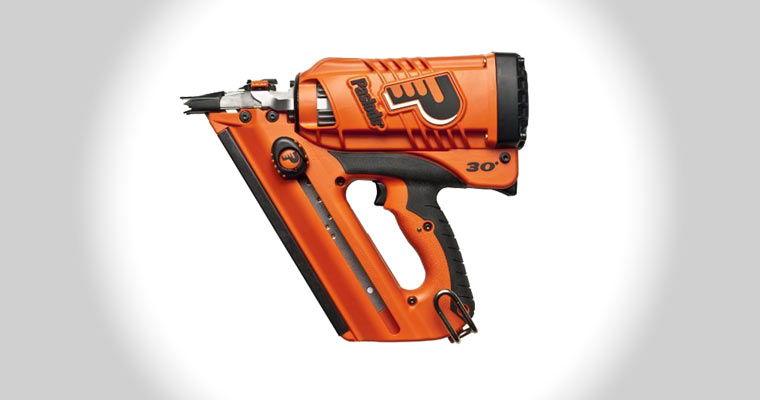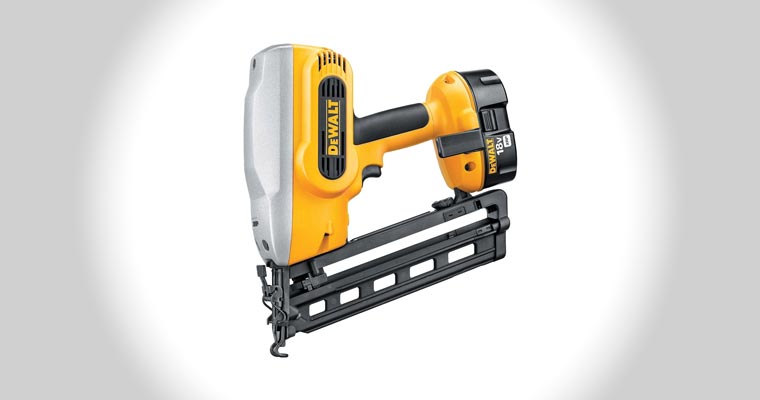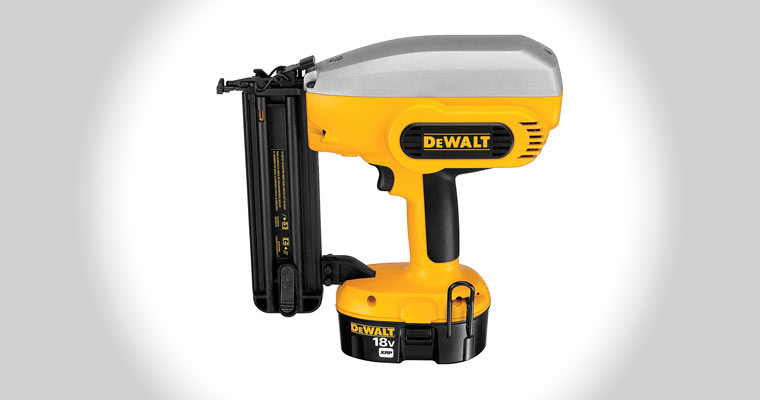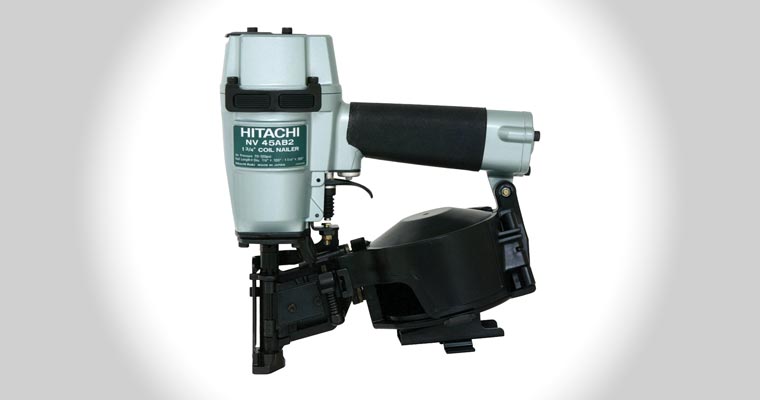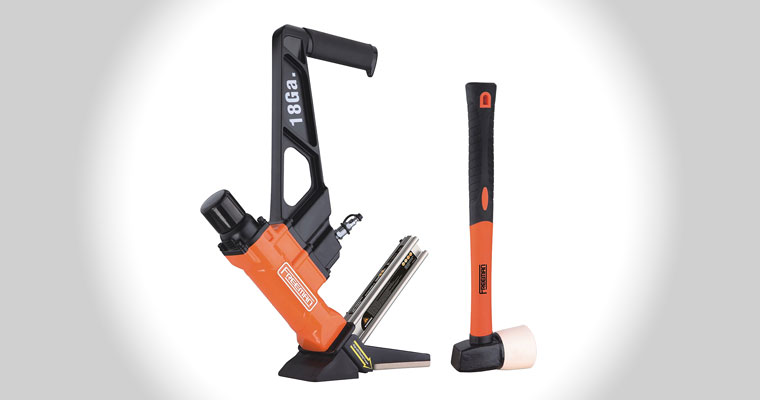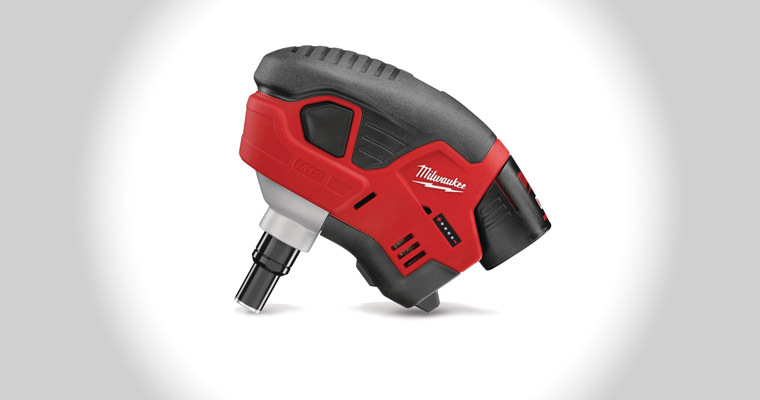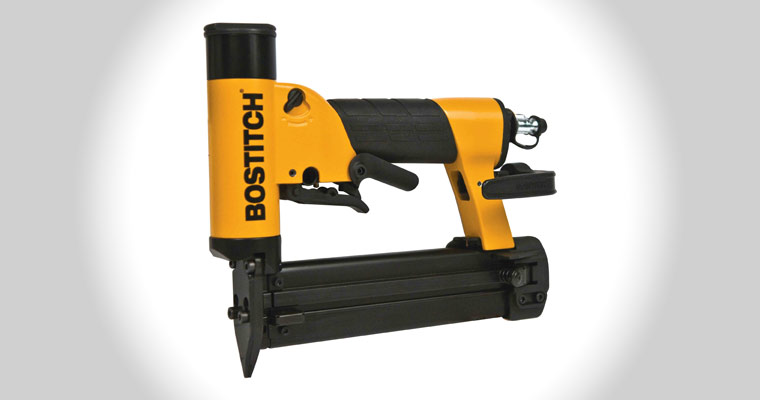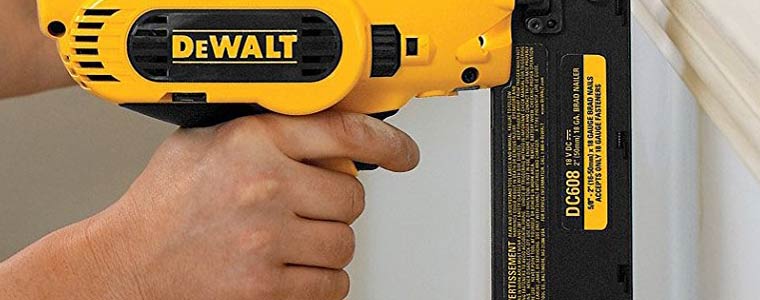There’s no two ways about it – nail guns save HUGE amounts of time.
The most important thing to keep in mind when buying a nailer is that there’s a different one suited for every project.
In this guide, we’ll break down 7 different types of nail guns for you and tell you which type of job each is best suited for.
Framing Nailers
Framing nailers are designed to tackle big jobs. If you’re looking for a nail gun that can shoot 3-inch nails through hardwood 2×4’s, you’re probably going to want to look at a framing nailer.
These are designed to shoot either clipped or round heads but with clipped heads are generally not considered to be up to code anymore. If you’re going to buy a framing nailer, make sure you get one that shoots round heads.
What jobs you can use a framing nailer for
- Framing new construction
- Building a deck
- Constructing a room addition
- Attaching wooden siding
Nails
Framing nails come collated and held together by paper, plastic, wire, or glue.
They range in angle depending on what framing nailer they’re designed for and they come in various lengths that range from 1 ½ to about 2 ¼ inches.
When buying nails for your gun, make sure you know the angle and the length. Most framing nailers will take a range of lengths, but the angle will always be the same.
Top Framing Nailer Choice: Paslode 902600 CF325Li Framing Nailer
We went with the Paslode 902600 CF325Li Framing Nailer as our top framing nailer pick.
This one is powered by a battery and a fuel cell so it comes with a lot of power. In fact, the battery will last for up to 5 hours and each charge can fire 6000 nails. If your battery runs out, there’s a 2-minute quick charge option that will let you fire about 200 more nails.
This framing nailer is sometimes referred to as a lightweight heavy duty nailer and it’s not hard to see why. With all that power, it only weighs 7.5 pounds and that includes the battery. It’s fast and accurate and will make short work of any big job.
>>> See our full list of the best framing nailers here
Finish Nailers
Finish nailers typically come in 15 and 16 gauge options. As their name implies, they’re meant to be used for detailed finishing work, which is why they use thinner nails than guns meant for larger jobs. These nails can also easily be hidden with putty to create a smooth surface when the job is done.
What jobs you can use a framing nailer for
- Installing baseboards
- Putting up chair rails
- Hanging crown molding
- Installing wood paneling
Nails
Finishing nails are pretty small, usually 16 or 18 gauge. They are usually collated using glue but you can find tape and wire, too.
Finishing nailers are usually straight but there are a few that are angled, usually around 20 degrees (see our guide on angled vs straight nailers ). The nails come in varying lengths ranging from about 1 ¼ – 1 ¾ inches.
Top Finish Nailer Choice: DEWALT DC618K XRP
The DEWALT DC618K XRP is an outstanding finish nailer kit that comes with almost everything you need to get started right away. It includes a battery and charger, not to mention a large rear loading magazine that can hold 110 nails. The 3-year warranty is great, but the 2 years of free service are even better.
This is a fast nail gun that can drive up to 5 nails a second. With the choice of sequential and bump mode, you have a lot of control with this one. You’ll also get more accurate results thanks to the LED light that illuminates your work surface so you can see exactly where your nails need to go.
>>> See our list of the best finishing nailers here.
Brad Nailers
Although they’re easily confused with finish nailers, brad nailers are actually quite different.
As we’ve said, finish nailers use 15 or 16 gauge nails. Brad nailers use much smaller ones 18 to even 23 gauge. These nails are actually so small that you’d have a hard time using a manual hammer.
Brad nailers are used for the most delicate projects. The nails are so small that you often can’t see them unless you’re looking for them. They might not even need putty to hide them when the job’s done.
What jobs you can use a brad nailer for
- Reupholstering furniture
- Crafting
- Attaching thin, delicate trim
- Installing light molding
Nails
Brad nails range in length from about 1 ⅛ to 1 ¾ inches. They’re angled and 34 degrees is the most common. They’re usually collated using glue and come in 16 or 18 gauge sizes.
Top Brad Nailer Choice: DEWALT DC608K
The DEWALT DC608K is a great choice if you’re in the market for a brad nailer. It has two modes to choose from: sequential mode for precision and bump mode for speed. Jams are always a risk, but if you run into trouble with the DEWALT DC608K, they’re easy to clear thanks to the easy access nose piece.
This battery powered tool is compact and able to fit into small spaces. Since there’s no need to drag around an air compressor, this brad nailer can go just about anywhere. The large magazine capacity means you can use it for a long time without reloading. This kit includes a nice amount of extras, including an 18V battery, charger, and a hard plastic carrying case.
>>> See our list of the best brad nailers here.
Roofing Nailers
It’s pretty obvious what a roofing nailer is for. Right?
They’re made to use with shingles and other roofing material and there are some design differences that make them especially suited for that job. For example, they have a wider head to help hold down the shingles without poking through the material.
The nails also come in coils instead of strips like they do for most other kinds of nailers.
Safety is always key, but roofing nailers are going to be used in a more dangerous situation so you want yours to be as safe as possible. Two specific safety features to keep in mind with a roofing nailer weatherproofing and a non-slip surface.
First of all, it’s likely that you’ll encounter more rain and wind while you’re on the roof installing shingles than you would in the kitchen putting up a chair rail. Weather proofing is important with a roofing nailer so you don’t have to worry about light exposure.
Next, since most roofs are sloped, having a non-slip grip on your roofing nailer is an easy way to prevent it from sliding away from you when you need to put it down.
What jobs you can use a roofing nailer for
- Installation of waterproof tar paper
- Attaching various kinds of shingles including:
- Asphalt
- Fiberglass
- Wood
- Metal
- Plastic
Nails
Roofing nailers are the only kind that take coiled nails. They typically range from 1 ¼ to 1 ½ inches and are made of galvanized or stainless steel.
Top Roofing Nailer Choice: Hitachi NV45AB2 Roofing Nailer
The Hitachi NV45AB2 is easily our top choice for a roofing nailer. Its rapid fire function shoots 3 nails a second so you know it’s fast. It also has a tool-free depth of drive adjustment so it’s accurate and versatile, too.
This nailer is weatherproofed so it can withstand a bit of moisture while you’re working with it on the roof. It also has a rubberized casing to help it stay put when you have to set it down while you’re working.
A carbide tipped nose helps you land the nail right where you wanted to. It lightweight and well-balanced so you have a lot of control over it and can even use it with one hand if you wanted to.
>>> See our list of the best roofing nailers here.
Flooring Nailers
Unsurprisingly, flooring nailers are meant to install flooring. There is a wide range of models available and they’re designed for different materials. Some are made for solid hardwood, tongue and groove fabricated flooring, and even exotic flooring like bamboo.
Make sure the flooring nailer you buy is meant to be used with the type of flooring you’re installing.
Flooring nailers can use a variety of fasteners, including T cleats, L cleats, or staples. Staples are less expensive but not nearly as effective in the long run as T or L cleats. Cleats are shaped like their name – either a T or an L. They’re equally as effective but if you do have a preference, make sure you choose a flooring nailer that works with the one you like better. There are a few flooring nailers that can use either one.
What jobs you can use a flooring nailer for
- Installing hardwood floors
- Installing fabricated tongue and groove flooring
- Installing exotic flooring
Nails
Flooring nails vary in length from 1 to 2 inches. Flooring nailers don’t have the angle that some other nailers do so the nails are available in 45 or 90 degrees. As covered above, you’ll find various shapes of nailers. L and T cleats are preferred because they give a little more hold. Staples will work but will loosen over time.
Keep in mind, you’re installing a floor that will hopefully remain in place for years to come. Using staples can lead to loose or squeaking boards in the future.
Top Flooring Nailer Choice: Freeman PF18GLCN Flooring Nailer
The Freeman PF18GLCN Flooring Nailer is somewhat specialized in that it can only be used with exotic flooring, including bamboo, Brazilian teak, cherry, and other rare hardwoods. Despite that, this is such an effective tool that we had to pick it as the best one.
This flooring nailer uses 18 gauge L cleats which are the perfect fastener for dense flooring. It’s comfortable and fast and, because it also holds 120 cleats, you can work for a long time and get the job done fast.
>>> See our list of the best flooring nailers here.
Palm Nailers
Palm nailers are a much more basic tool than some other that you will find in this list.
They typically drive one nail at a time and are designed to get into those places where it would be impossible to swing a hammer or fit in a bulkier type of nailer. Some models can drive some pretty impressive nails – up to 6 inches in some cases! Palm nailers use standard nails but they have to be fed into the tool on at a time.
What jobs you can use a palm nailer for
- Framing
- Remodeling projects
- Between wall studs
- Building fencing
Nails
Palm nailers don’t require any kind of special nails. Get the kind that will fit both your nailer and the job you’re going to be doing.
Top Palm Nailer Choice: Milwaukee M12 Cordless Palm Nailer
For our top palm nailer choice, we went with the Milwaukee M12 Cordless Palm Nailer.
This is one of the few cordless nailers available. Not only is it small and compact but there’s no compressor hose to worry about so you really can squeeze it into just about any small space. The integrated LED lights make it easy to see what you’re doing when you do need to get into the smallest spaces.
One of the great things about this palm nailer is that it comes with the battery and charger included. While this one might not be a great choice for professionals, it’s an ideal little tool to have around the house for the various projects that come up.
>>> See our list of the best palm nailers here.
Pin Nailers
Pin nailers are generally used in conjunction with wood glue.
The fasteners usually don’t have a head and aren’t very supportive on their own. These are great in situations where you’re using small, delicate pieces of wood or if you’re gluing something together that’s too small or awkward for a clamp.
Because the fasteners are so small, they typically don’t even need to be covered with putty. This is a great tool for fine detail work or even smaller arts and crafts.
What jobs you can use a pin nailer for
- Installing fine trim
- Holding wood together instead of a clamp
- Some cabinetry work
Nails
You don’t need to worry about angles with pin nails. They are usually 23 gauge, collated with glue, and even come in bright colors because they’re so small and difficult to see once you actually drive them into the wood. They typically range in length from ¾ to 1 ¾ inches.
Top Pin Nailer Choice: BOSTITCH HP118K Pin Nailer
The BOSTITCH HP118K Pin Nailer has a tapered, low profile nose so you can clearly see where you’re driving the pin.
There’s an adjustable power switch so you can control the depth of drive without worrying about adjusting the air compressor. The magazine holds 200 pins so you can work for a really long time without having to worry about reloading.
At only 2.5 pounds, this is a really lightweight tool. The durable aluminum housing not only contributes to how light it is but also makes it exceptionally durable and able to stand up to some abuse. With this nailer, you get a set of 23 gauge pins, tool lubricant to help with maintenance and upkeep, and a hard plastic case for storage.
>>> See our list of the best pin nailers here.
Things to Know When Buying a Nail Gun
While each nail gun is designed to be used for a different job, there are a lot of things that they all have in common. No matter what type you’re in the market for, there are some general things that you should know in order to make your selection process a little easier.
Firing Modes and Triggers
To drive the nail, a nail gun relies on a finger trigger and a contact safety tip on the nose of the gun. There are a few different trigger options to consider, too.
A contact trigger fires a nail when both the trigger and the contact safety tip are both activated. So, you have to squeeze the trigger and have the tip placed firmly against the material for the nail to shoot. If you hold the trigger between nails, you don’t have to let go and reactivate it. As long as you’re holding onto the trigger, when the tip hits the surface, it will fire a nail.
A single actuation trigger requires that both the trigger and the contact tip must be activated to fire a nail, but they can be done in any order. The process has to be repeated for each nail.
A full sequential trigger means that there’s an order that things have to be activated in order to get the nail to fire. First, the tip has to make contact with the surface and then the trigger can be squeezed to drive the nail. It will only drive one at a time. For the next one, the sequence has to be started all over again – push the tip into the material, pull the trigger. Because firing a nail is such a deliberate process with this type of trigger, it’s often considered the safest.
A single sequential trigger is similar to this in that the tip has to be in contact with the surface and then the trigger has to be squeezed to drive a nail. The tip can stay in contact with the surface and the trigger can be pulled again to shoot multiple nails.
A bounce trigger is used in situations where you want to work fast. You basically squeeze and hold the trigger and then quickly bounce the nose along
Power Sources
There are three different options of power sources. They can either use a battery, a combination of a fuel cell and a battery, or an air compressor. There are pros and cons to all three.
Battery
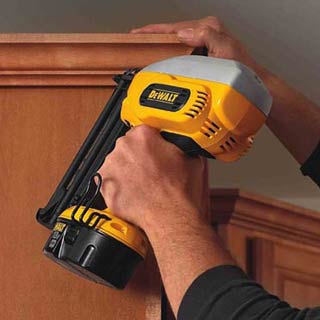
Fuel/Battery Combination
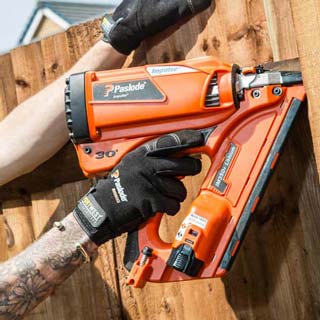
Pneumatic/Air Powered
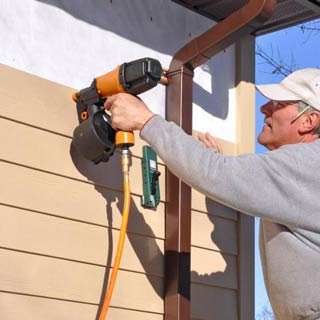
Air powered nailers last a long time because there are fewer parts, which means fewer things to break. They’re also extremely consistent and deliver the same amount of power to each and every nail. Most air powered nailers need a little more maintenance than their counterparts. They’re also the loudest and can be quite disruptive. They’re not as portable as battery powered options but with a fully charged compressor, you can take your pneumatic nailer just about anywhere you need to go.
Materials
Galvanized steel and aluminum are pretty popular ones. Aluminum is especially popular because it’s lightweight and durable so you’ll get a good, solid tool that is easy to hold onto. It’s a good idea to avoid nail guns that have a lot of plastic parts simply because plastic is much more likely to break than metal.
Ergonomics
Depending on the job you’re completing, it’s likely you’ll be holding onto your nailer for extended periods of time. If you’re installing a roof or a floor or taking on a large project like framing a house, you need to be able to work for long stretches of time. Having a tool that’s ergonomically designed will prevent cramping in your hands and muscle fatigue, allowing you to work for longer periods of time with little to no discomfort.
Loading Styles
Nails come in either long sheets of nails that are connected by paper, wire, or even glue. They’re set at different angles which will correspond to the angle of your nail gun. They range in how many they’ll hold, but the longer the sheet, the longer your magazine is going to have to be to accommodate it.
Coils are the other option and are most popular with roofing nailers. One big thing to mention is that they can hold more nails since they take up less space. You can easily get a coil with about 300 nails in it, which will last you a really long time.
Angles
When you look at certain kinds of nailers, like a framing nailer or flooring nailer, you’ll see that the magazines are placed at an angle. The angle is usually included in the product description. The only thing you really need to be concerned with when it comes to angles is that it will affect how close you’ll be able to get to corners and walls and whether or not you’ll be able to fit into small spaces.
Features and Extras
There are a lot of extra features and accessories that you’ll find as you look into finding the right nailer. While these things aren’t necessary, for the most part they will make using and owning a nail gun more fun, less stressful, and more enjoyable.
- Depth adjustment. This is really important if you’re a professional or someone else who will use your nailer for a variety of jobs and use a range of materials. Depth adjustment, sometimes called depth of drive adjustment, determines how far into the surface the nail will go. This will be done manually in some nailers while others will have a dial that changes the depth with a simple twist.
- Nail size adjustment. The more sizes of nails your gun can take, the more versatile it will be because you can use it on more materials.
- Swivel air connectors. One of the drawbacks of a pneumatic nailer is that the air hose can add weight and tension to the nailer. A swivel air connector allows the tube to spin and actively respond to gravity so you don’t have to pull against it as much.
- Jam clearing. Top end nailers won’t jam often, but having one every so often is inevitable. Some nailers have very effective jam clearing mechanisms in place.
- Dry fire lockout. If you let the magazine run empty and fire when there are no nails left, it’s possible that you will damage the inside of your nailer. Also, it’s possible that you might be so focused on your work that you just keep going without realizing that you’re no longer actually firing any nails. A dry fire lockout stops the gun from firing when there’s only a handful of nails left in the magazine.
- LED light. Some kinds of nailers come with an integrated LED light that will help you see where you’re driving the nail just a little bit better. This is particularly important if you’re using it in a tight space and can’t see very well.
- Air duster. To keep dust and debris away from your work surface, some nailers will have an integrated air duster. This is also a really great way to help with cleanup after the job is done.
- Rafter hooks. There’s no safer or more convenient way to put your nail gun down on the job-site than with a rafter hook. They let you hang your nailer out of the way so that you don’t need to worry about it while you’re doing other work. It will also keep your tool close by so you can easily get back to work.
- Directional exhaust. If you’ve ever used a power tool that blew its exhaust right in your face, you know why this is such a valuable feature. It lets you change the direction that the exhaust is blowing to keep it away from you and the surface that you’re working on.
- Protective case. Having a case for any tool is nice. It gives you a safe place to store it when it’s not in use and provides you with an easy way to carry your nailer from place to place.
Finding the Right Nailer
As we stated earlier, finding the right nailer heavily depends on what job you’re going to be doing. A palm nailer would be a bad choice for a roofing job just like a framing nailer would be awful at delicate trim work. There really is a wide range of jobs that nail guns are essential for but you have to be able to determine which kind you need to do the job. Once you’ve figured out the style you need, use the information we put together in this guide to help you understand all the different elements to look for in order to find the right one for you.
If you want to get a little more in depth into each type of nailer, check out our other guides where we examine each one independently. You’ll find in depth analysis and reviews of more of the top performers in each category.
